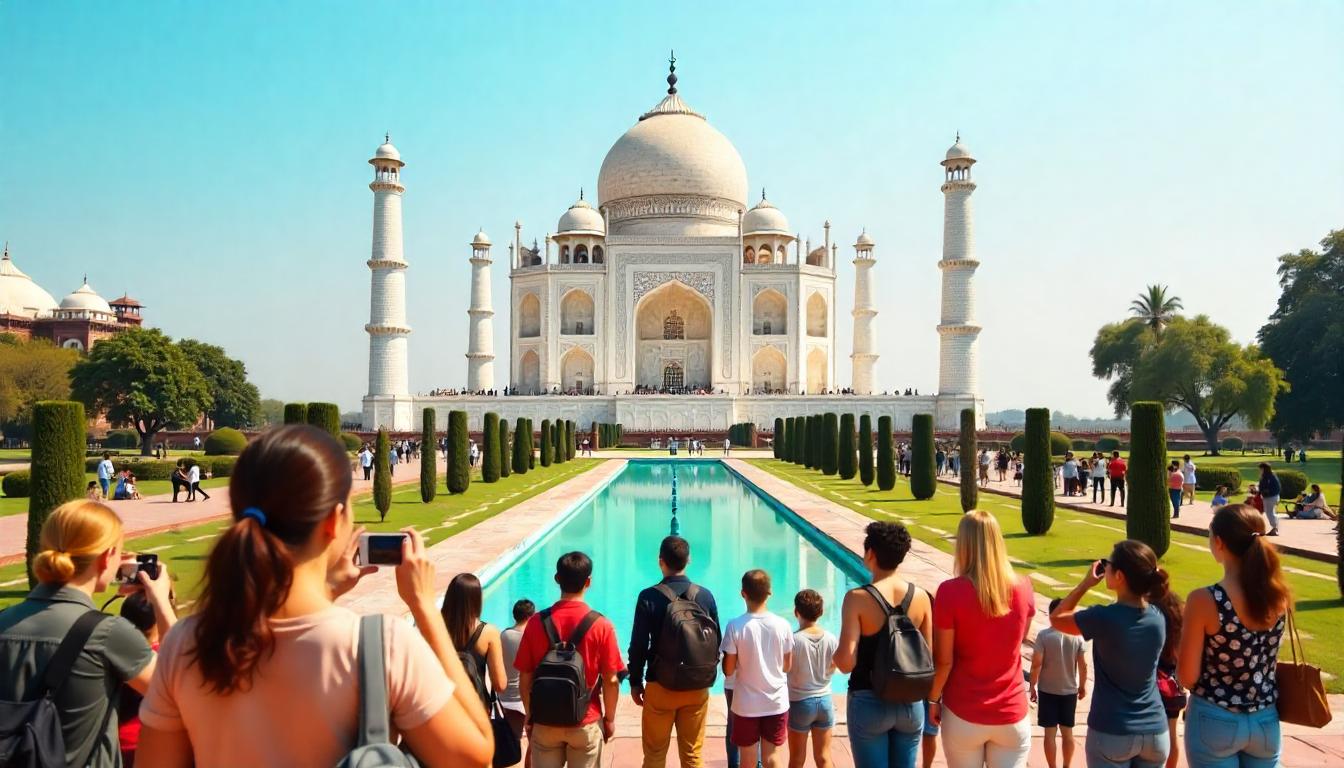≡-Why India’s Tourism Industry Faces a Major Challenge Following the U.S. Level 2 Travel Alert and How It Could Affect Future Travel Plans in 2025: You Need to Know – Viral of Today
<> Viral of Today <>
Home » America Travel News » Why India’s Tourism Industry Faces a Major Challenge Following the U.S. Level 2 Travel Alert and How It Could Affect Future Travel Plans in 2025: You Need to Know Sunday, June 22, 2025India’s tourism industry is facing a serious challenge in the wake of the U.S. State Department’s Level 2 travel alert issued in June 2025, which urges American travelers to exercise greater caution due to rising crime, terrorism threats, and increasing safety concerns—particularly for women—in several tourist hotspots. As one of the largest source markets for inbound tourism to India, the U.S. advisory could significantly impact travel sentiment, disrupt recovery momentum post-pandemic, and lead to a decline in international arrivals. This development may influence not only American tourists but also prompt other countries to reassess their travel guidance, affecting travel plans and industry revenues across India through the remainder of 2025.U.S. State Department’s Travel Warning on India: A Mixed Response and Its Impact on TourismOn June 16, 2025, the U.S. State Department released a Level 2 travel alert for India, advising American tourists to take extra precautions when traveling to the country. The advisory, which has sparked significant debate, highlighted concerns about crime, terrorism, and rising incidents of violence, particularly sexual assaults at tourist destinations and public spaces. The advisory, while signaling the need for heightened vigilance, has also drawn criticism from Indian authorities and the media, with many arguing that it overstates the risks and could harm the country’s tourism industry.What Does the Travel Advisory Mean for India?The U.S. State Department issues travel alerts using a four-tiered system to assess the safety of a destination. These range from Level 1, which recommends normal precautions, to Level 4, which advises against travel altogether. The Level 2 advisory issued for India signals an increase in potential risks, advising travelers to be cautious and follow local guidelines. While not as severe as a Level 3 or Level 4 alert, which calls for reconsidering or avoiding travel, the Level 2 warning nonetheless paints a picture of a destination where safety concerns are prominent.The advisory raised alarms about rising incidents of violent crime, including sexual assaults in popular tourist areas. In particular, the regions of Jammu and Kashmir, Manipur, and parts of central and eastern India were highlighted with Level 3 (“Reconsider Travel”) or Level 4 (“Do Not Travel”) designations. These regions have long been subject to political unrest and violent clashes, further compounding the risk assessment.The U.S. State Department’s advisory also cautioned against traveling to remote or less accessible areas, particularly those far from major cities, where U.S. government support and emergency services may be limited. Tourists were advised to exercise caution in tourist hotspots, including Goa, Rajasthan, and Delhi, where incidents of harassment and assaults have recently been reported.The travel advisory also cautioned that bringing satellite phones or GPS devices into India could lead to fines or imprisonment, as these items are prohibited within the country. The advisory also emphasized the importance of registering with the Smart Traveller Enrollment Program (STEP) to receive real-time updates on travel safety and to ensure that travelers have appropriate insurance coverage in case of emergencies, including medical evacuation.India’s Official Response: A Mixed ReactionThe Indian government, through its Ministry of External Affairs, responded to the travel warning with a mix of criticism and restraint. Randhir Jaiswal, a spokesperson for the Ministry, called the U.S. travel advisory “unfortunate,” arguing that it did not accurately reflect the safety situation in India. He emphasized the country’s commitment to improving its security measures and noted that the rise in crime should not overshadow India’s reputation as a safe and culturally rich destination for travelers.In contrast, Indian media have strongly opposed the advisory, with multiple outlets accusing the U.S. of inflating the risks in an effort to harm India’s tourism industry, especially as geopolitical tensions between the two nations escalate. The Times of India published an editorial titled “Unfair Alarmism,” arguing that such alerts could have a detrimental effect on an industry that contributes nearly 7% to India’s GDP. The piece suggested that the advisory may be more politically motivated than based on actual safety concerns.On social media platforms like X, users have expressed mixed opinions. Some argue that the advisory is an overreaction, while others believe it reflects underlying issues that need to be addressed. The debate centers on whether the U.S. State Department’s warnings are rooted in legitimate threats or are a reflection of Western bias against India.The Impact of the Advisory on India’s Travel and Tourism IndustryIndia has long been a top travel destination, attracting millions of tourists annually. In 2024, the country welcomed over 10 million international visitors, with Americans accounting for a significant portion of that number. The travel warning could have a considerable impact on the industry, particularly as global tourism is expected to rebound to 95% of pre-pandemic levels in 2025.The U.S. is one of India’s most important source markets for international tourism. In 2024, approximately 1.7 million Americans visited India, contributing billions of dollars to the economy through spending on airlines, hotels, restaurants, and shopping. A decrease in American visitors, whether due to the advisory or other factors, could affect various sectors within India’s tourism industry.The travel warning may also influence other nations to reconsider their travel advisories for India. The UK, Canada, and Australia have already issued similar warnings regarding crime and terrorism in major Indian cities like Mumbai and Bengaluru. If these countries follow the U.S. lead and upgrade their travel alerts, India could see a sharp decline in tourist arrivals, further impacting the economy and industry jobs.Tourism experts argue that bad news about safety can quickly undo the positive impact of marketing campaigns designed to promote a country as a desirable destination. Similar declines in tourism were seen in Egypt following major terror attacks in 2015, when many travelers reconsidered their trips due to safety concerns. Industry leaders in India have called for stronger measures, such as increasing the presence of tourist police and launching awareness campaigns to reassure visitors of their safety.The Growing Safety Concerns: Focus on Women TravelersThe U.S. State Department’s Level 2 alert for India pays special attention to the risks faced by women travelers. The advisory strongly advised women against traveling solo in India, highlighting a rise in sexual violence in popular tourist destinations. Data from India’s National Crime Records Bureau revealed a disturbing 19% rise in reported rapes from 2020 to 2023. Tourist destinations in Goa, Rajasthan, and Delhi have seen high-profile cases that have drawn international media attention, further elevating concerns about the safety of women visiting India.In particular, the advisory advised women to use women-only public transport in cities like Delhi and Hyderabad and to avoid poorly lit, remote areas at night. The U.K.’s Foreign Office has echoed similar advice, warning British women about the potential for assault in various parts of India.Several high-profile incidents have increased anxiety around women’s safety. For instance, in March 2025, an Australian tourist was reportedly assaulted near the Taj Mahal in Agra by a local guide, prompting widespread media coverage. In January 2025, a Canadian visitor filed a complaint after being harassed in Delhi’s Connaught Place, while a 2024 case in Goa, where a British woman was raped on a beach, further fueled the discourse on women’s security.Despite these incidents, many women continue to visit India, often citing the country’s rich cultural offerings and vibrant tourism industry. Increasingly, female travelers are turning to women-only tours and group travel experiences to mitigate risks. However, the recurring reports of harassment and assaults have led to calls for greater accountability, better law enforcement, and improved safety measures to make India a safer destination for women.Addressing the Safety Concerns: India’s Path ForwardWhile the U.S. travel advisory does not call for a complete halt to travel to India, it urges careful planning and awareness. For the travel industry, this moment serves as an opportunity to reassess security protocols and make meaningful improvements to ensure that visitors feel safe and confident.India’s government and tourism industry will need to address safety concerns transparently. Steps may include more robust law enforcement in tourist-heavy regions, improved training for local police to handle cases of harassment and assault, and stricter regulations on tourist guides and services. Moreover, ongoing campaigns to educate travelers about basic safety precautions—such as avoiding isolated areas at night and using trusted transportation services—will help mitigate some of the risks associated with travel.In addition to addressing sexual violence, India could work on strengthening its infrastructure for emergency response and support for foreign nationals, particularly in rural areas where services are more limited. Enhanced diplomatic dialogues with countries like the U.S., the UK, and others could help improve international relations and ensure that travel warnings are based on a fair and accurate assessment of risks.India’s tourism industry faces a major setback after the U.S. issued a Level 2 travel alert in June 2025, warning of rising crime and safety risks that could disrupt travel plans and reduce international arrivals throughout the year.Conclusion: Navigating the Challenges of Global TourismAs India continues to emerge from the shadow of the pandemic, it faces new challenges in maintaining its reputation as a premier tourist destination. The U.S. State Department’s Level 2 travel advisory serves as a reminder of the importance of ensuring the safety and well-being of international travelers, especially women. For India’s tourism industry to thrive, it must balance the promotion of its incredible cultural heritage and attractions with the need to address safety concerns head-on.Travelers are encouraged to follow official advice, plan their trips carefully, and stay informed of any changes to safety conditions. With thoughtful planning, India can continue to be a destination that attracts millions of visitors from around the world, offering them a unique and unforgettable experience while ensuring their safety and well-being.As the country looks forward to a future of growth and recovery in its tourism sector, the actions taken now will determine how it is viewed by the global travel community for years to come.Tags: geopolitical tensions tourism, India Tourism, India travel advice, India travel risks, International travel advisory, Level 2 travel advisory, tourism and safety, tourism industry impact, tourist hotspots India, Tourist Safety, travel planning, travel safety India, U.S. State Department, U.S. travel alert, U.S. travel warnings, women’s safety
This information will surprise you!
See also
- Read until the end to discover everything.
- Important information you need to know.
- Interesting facts and helpful tips.
Conclusion
Did you enjoy the news? Keep following us daily!













